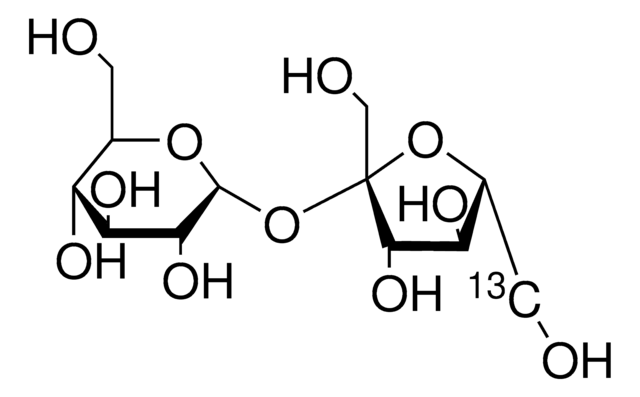1.07651
Saccharose
suitable for microbiology
Synonyme(s) :
α-D-Glc-(1→2)-β-D-Fru, α-D-Glucopyranosyl β-D-fructofuranoside, β-D-Fructofuranosyl-α-D-glucopyranoside, D(+)-Saccharose, Sucre
About This Item
Produits recommandés
Forme
solid
Niveau de qualité
Puissance
29700 mg/kg LD50, oral (Rat)
Durée de conservation
limited shelf life, expiry date on the label
Conditionnement
pkg of 1 kg
pkg of 25 kg
pkg of 5 kg
pH
7 (20 °C, 100 g/L in H2O)
Pf
185-187 °C (lit.)
Masse volumique apparente
800‑950 kg/m3
Application(s)
microbiology
Température de stockage
15-25°C
Chaîne SMILES
OC[C@H]1O[C@H](O[C@]2(CO)O[C@H](CO)[C@@H](O)[C@@H]2O)[C@H](O)[C@@H](O)[C@@H]1O
InChI
1S/C12H22O11/c13-1-4-6(16)8(18)9(19)11(21-4)23-12(3-15)10(20)7(17)5(2-14)22-12/h4-11,13-20H,1-3H2/t4-,5-,6-,7-,8+,9-,10+,11-,12+/m1/s1
Clé InChI
CZMRCDWAGMRECN-UGDNZRGBSA-N
Vous recherchez des produits similaires ? Visite Guide de comparaison des produits
Catégories apparentées
Description générale
Application
Remarque sur l'analyse
Spec. rotation (α 20/D; 26 %; water): +66.2 - +66.8 °
Heavy metals (as Pb): ≤ 0.001 %
TLC-Test: passes test
Loss on Drying (105°C): ≤ 0.5 %
Suitability for microbiology: passes test
Code de la classe de stockage
11 - Combustible Solids
Classe de danger pour l'eau (WGK)
WGK 1
Point d'éclair (°F)
Not applicable
Point d'éclair (°C)
Not applicable
Certificats d'analyse (COA)
Recherchez un Certificats d'analyse (COA) en saisissant le numéro de lot du produit. Les numéros de lot figurent sur l'étiquette du produit après les mots "Lot" ou "Batch".
Déjà en possession de ce produit ?
Retrouvez la documentation relative aux produits que vous avez récemment achetés dans la Bibliothèque de documents.
Les clients ont également consulté
Notre équipe de scientifiques dispose d'une expérience dans tous les secteurs de la recherche, notamment en sciences de la vie, science des matériaux, synthèse chimique, chromatographie, analyse et dans de nombreux autres domaines..
Contacter notre Service technique




